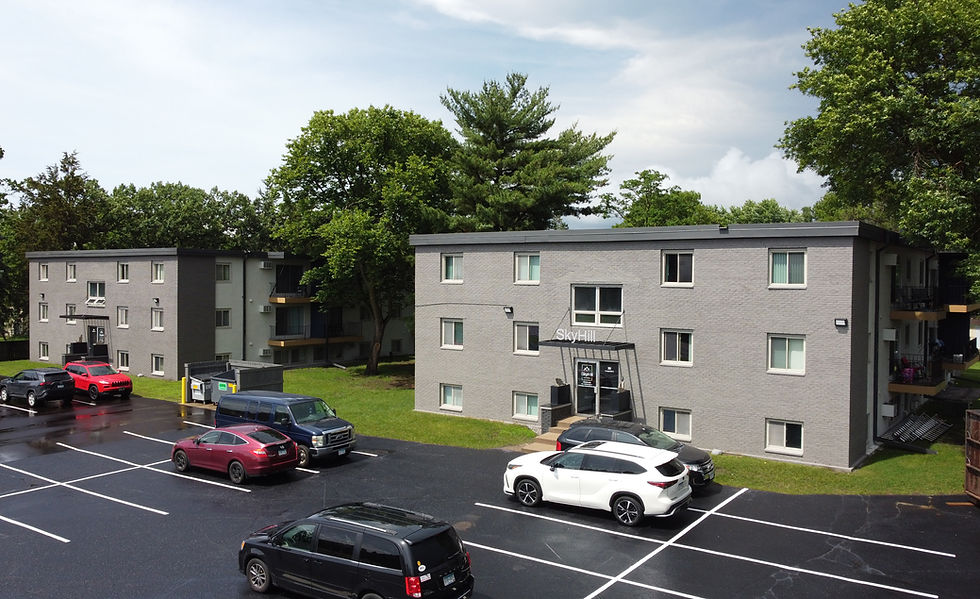Let Builders Build!
- Ridgeview Property Group

- Oct 9, 2023
- 4 min read
Updated: Jan 7

The Ridgeview Report
In today's edition, I share a case study of the Daymark Uptown Apartments in order to show just why municipalities and residents alike should be open to new development.
Case Study: The Daymark Uptown Project
In 2019, a developer acquired 2.4 acres of land in Uptown Minneapolis with a vision to create the 328-unit Daymark Uptown. This ambitious undertaking involved replacing an older office building and two large surface parking lots with a vibrant residential complex. Below is a comparison of the tax revenue paid out before and after the development:
2019 Tax Assessment (Office building + parking lots)
Assessed value: $8.1 million
Property taxes: $301,000
2023 Tax Assessment (Apartment Complex)
Assessed value: $93 million
Property taxes: $1.63 million
Some quick math reveals that the same piece of land is now paying out $1,330,000 more in tax revenue each year. Now consider that dozens of similar properties are being built every year! It's a testament to the transformative power of real estate development.
Let's explore all the benefits that cities stand to gain when they invite development.

1. Boosting Tax Revenue
The primary and most immediate benefit of facilitating real estate development is the substantial increase in tax revenue for the city. As our case study demonstrated, the assessed value of properties can skyrocket following development. This translates into higher property taxes for the city, providing an essential source of income for public services, infrastructure improvements, and community development.
Consider this on a broader scale; when cities encourage and streamline the development process, they create an environment where investors are more willing to initiate projects. This results in a cascade of economic growth, leading to higher property values and increased tax revenue.
Over time, the additional tax revenue can be channeled into essential city services such as education, healthcare, transportation, and public safety. It empowers municipalities to undertake ambitious initiatives that enhance the overall quality of life for their residents.
2. Organically Expanding the Supply of Affordable Housing
One of the most pressing challenges faced by cities worldwide is the affordability of housing. As urban populations continue to grow, the demand for housing often outstrips the supply, driving up prices and making homeownership an elusive dream for many. However, real estate development can be a potent solution to this problem.
When cities make development easier, developers are more inclined to create housing units to meet the rising demand. This increased supply not only curbs the escalation of housing costs but can also lead to the creation of naturally affordable housing options.
The economics behind this concept are straightforward. As new housing units are introduced to the market, the competition among landlords and property owners intensifies. This, in turn, exerts downward pressure on rental rates and housing prices, making it more accessible for a broader segment of the population.

3. Job Creation and Economic Growth
The construction and management of new buildings are engines of job creation and economic growth. Real estate development projects involve a multitude of skilled and unskilled labor, from architects and engineers to construction workers and maintenance staff. Each development becomes a catalyst for employment opportunities, injecting vitality into the local economy.
Furthermore, the positive economic ripple effects extend far beyond the construction phase. As new residents move into these developments, they become consumers who contribute to the local economy through spending on goods and services. This bolsters local businesses and stimulates further economic growth.
The construction industry, in particular, is known for its ability to weather economic downturns. By encouraging development, cities can establish a buffer against economic instability, as the construction sector continues to generate jobs and stimulate economic activity even during challenging times.
Conclusion: A Brighter Future Through Development
In conclusion, making real estate development easier is not just a policy decision; it's a strategic investment in the future of our cities. By embracing development, cities stand to benefit in numerous ways, from increased tax revenue and affordable housing to job creation and economic growth.
The case of the Daymark Uptown project in Minneapolis serves as a compelling example of the transformative power of development. It demonstrates how a single development can inject vitality into a city, providing a long-term income stream, fostering affordability, and creating job opportunities.
-Ben Michel
Ben Michel is the founder of Ridgeview Property Group, an investment firm specializing in acquiring multifamily real estate. Register Here to be notified of available investment opportunities.
Market News
Daymark Uptown Apartments You can read more about the development process of the Daymark Uptown Apartments in the below article by Finance & Commerce. The article explores the details of this significant project, showcasing the architectural and economic successes it brought to the neighborhood.
Source: Finance & Commerce. Top Projects of 2020: Daymark Uptown Apartments. https://finance-commerce.com/2021/07/top-projects-of-2020-daymark-uptown-apartments/
Tips and Tricks
Terms:
Tax Assessment- A tax assessment is the process of determining the monetary value of a property or asset for taxation purposes. This assessment is typically carried out by local government authorities to calculate the property taxes owed by the owner based on the assessed value of the property.
Assessed Value- Assessed value is the estimated monetary worth assigned to a property by local government authorities for taxation purposes. It serves as the basis for calculating property taxes, with the assessed value influencing the amount a property owner is required to pay in taxes.







